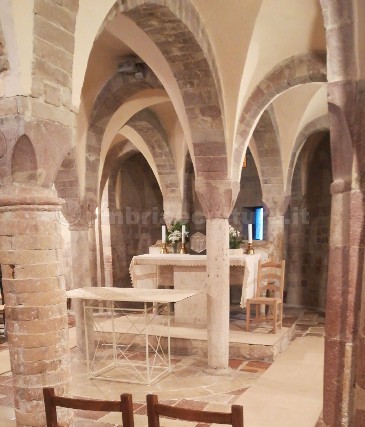The Abbey of San Felice in Giano dell’Umbria opens its millenary doors for a visit to discover the history and many curiosities surrounding the use of oil in the Middle Ages. A journey through the rooms of the Abbey, once inhabited by Benedictines, Franciscans and Augustinians, to learn about the history of the famous “San Felice” oil and discover the art treasures that this place holds. An itinerary between history, art, architecture and olive growing in a real leap into the past.
Giano dell’Umbria is famous for the production of the olive oil, and there, each year in November, takes place the “Festa della Frasca” a two days event linked to the end of the olive harvest and to the green gold of Giano dell’Umbria.
The Festa della Frasca is a suggestive parade that crosses the streets of the castle of Giano dell’Umbria. To open the parade a cart pulled by oxen carrying the branches decorated with food once considered very precious by the farmers. The chariot is followed by participants who wear period clothes such as guazzarone, a tunic that was used to shelter from humidity and cold, carrying tools for the olive harvest. Once in the town hall square, the party explodes with the tasting of the tasty bruschetta (toastes bred with the new olive oil) and the wine from the Giano hills where the Abbey of San Felice stands.
Located on a natural terrace on the slopes of the Martani Mountains, few kilometers from Giano dell’Umbria, in an isolated and dominant position, stands the Abbey of San Felice whose origins are still being studied today. The first nucleus of the abbey dates back to the fourth century, with the construction of a chapel to guard the remains of San Felice, bishop of Vicus ad Martis and Martyr under Diocletian and Maximilian. The legend says that after the long martyrdom of the saint, some Christians of Massa Martana decided to bury the remains of the bishop. They left with a cart dragged by two oxen who, at a certain point of the journey, knelt: they interpreted this sign as a divine sign and built the chapel there.
Above this “oratory” in the XII century the church and the annexed monastery were built, while according to Ludovico Jacobilli, a well-known historian from Foligno, the institution of the complex dates back to 950 in conjunction with the establishment of a Benedictine community. We are in 1373 when Pope Gregory XI placed the Abbey of San Felice under the jurisdiction of the Abbey of Santa Croce di Sassovivo. In 1450 Pope Nicholas V, wanted to reactivate the religious functions that had been suspended for some time due to the dilapidation of the church, so he entrusted the abbey complex to the Congregation of the Hermits of Sant’Agostino who took formal possession of it in 1496. Several, in those years, were the interventions of restoration to which the Abbey was subjected: the cloister, the elevation of the side aisles of the church, the addition of a semicircular loggia above the central nave, a new facade, the raising of the bell tower and the construction of the refectory in past main entrance.
After being accused of immorality and tax evasion in 1798, the Augustinians were removed from the abbey and the property confiscated and donated to the municipality of Spoleto. After the Augustinians it was the turn of the Passionists. In 1814 the Roman priest Gaspare del Bufalo founded his congregation of the Missionaries of the Precious Blood in the abbey of San Felice. The statue of the priest stands imposingly in front of the church. Following the suppression of the religious guilds in 1860, the missionaries left the San Felice complex to come back in 1937. Since then the abbey has been guarded by the priests of San Gasparre.
From a purely architectural point of view, the plant is common to other churches in the area: San Gregorio Maggiore di Spoleto, San Silvestro and San Giacomo di Bevagna and San Pietro di Bovara. These churches have common stylistic and constructive features, such as: plan with three apsed naves, raised presbytery with crypt below and three-mullioned window on the facade.
The church is the result of a purist restoration carried out in 1950 that has abolished all the baroque details testified by two photos currently kept in the Abbey premises. The facade, in white and pink stone of the San Terenziano quarry, which is currently a hut with a triple lancet window in the center, the access portal splayed with round arches and a travertine lintel decorated with leaves. The interior is divided into three naves. The presbytery and the three apses are separated from the rest of the church by a steep travertine staircase. Under the presbytery there is the heart of the church, the crypt in which Roman artifacts belonging to the disappeared “Città Martana” were reused. Defined crypt ad horatorum, it is divided into three naves, has numerous columns and five bays.
Inside the crypt, especially on the capitals, the stonemasons had fun leaving archaic and primitive designs that we find in medieval clothing. Behind the altar the tomb that preserves the ashes of San Felice, it is a sort of tabula ansata raised on four columns so as to allow the faithful to “crawl” underneath and have direct contact with the relic of the Saint with which miraculous healing qualities were associated, especially for rheumatological diseases.
The cloister has a rectangular plan and consists of brick pillars. It consists of two superimposed loggias and inside the rectangle it has a cistern for collecting rainwater. The cloister, with the exception of the church which has only a poor fragment of a fresco, is painted by a series of frescoes with a very rough and homemade taste and workmanship, most likely made by a friar of the abbey such as Giuseppe Franciosi who delighted in the art of painting. On one side of the courtyard, among the frescoes, we find in chronological sequence the main biographical events of the life of San Felice and the construction of the Abbey; on the other hand, however, the frescoes have San Gaspare del Bufalo as protagonist.
In the part of the abbey complex that overlooked the estates, in the past there was a mill. In fact, the monks were (and are) great oil producers who used it, not only for seasoning meals, but also as a fuel for lighting, as an ointment and solvent for their products, among which the Samaritan Balsam, made with oil, wine and egg, stands out for its fame and virtue, effective for decongesting and flaming. Nothing was thrown away from the olive tree and the leaves, in fact, were used in decoctions or reduced to ash as an anti-inflammatory.
Currently San Felice oil, produced only and exclusively in the Abbey area, is among the most valuable.
Find the Abbey of San Felice in Giano dell’Umbria on Google Maps:



